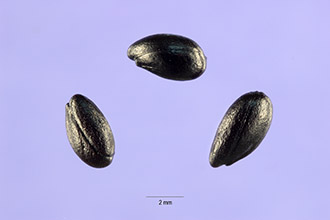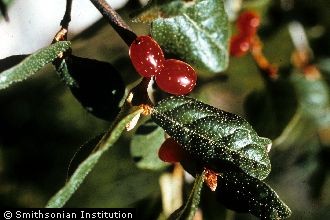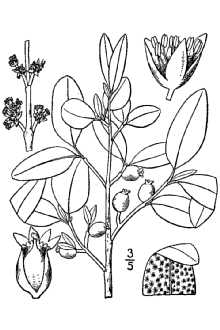Russet Buffaloberry
Scientific Name: Shepherdia canadensis (L.) Nutt.

| General Information | |
|---|---|
| Usda Symbol | SHCA |
| Group | Dicot |
| Life Cycle | Perennial |
| Growth Habits | Shrub |
| Native Locations | SHCA |
Plant Guide
Alternative Names
soapberry, buffalo-berry, russet buffaloberry, russet red buffaloberry, Canadian buffalo-berry
Uses
Ethnobotanic: Buffaloberry berries were used to make “Indian ice cream” which has a bitter taste but was often sweetened with salal berries, camas bulbs, or hemlock cambium (Pojar & MacKinnon 1994). The berries were also eaten fresh or dried. The Wet’suwet’en used the twigs, leaves, berries, and juice medicinally for everything from heart attacks to indigestion. The berries were also chewed by Wet’suwet’en women to induce childbirth. The Salish and Kootenai tribes boiled debarked branches and used the solution as eyewash. A poultice of the inner bark, softened by hot water and mixed with pin cherry bark (Prunus pensylvanica) has been used to make a plaster or bandage for wrapping broken limbs (Moerman 1998). Landscaping & Wildlife: Shepherdia canadensis plants are grown occasionally for ornamental use. The berries are browsed by grouse, black bears, grizzly bears, and snowshoe hares.
Status
Please consult the PLANTS Web site and your State Department of Natural Resources for this plant’s current status, such as, state noxious status and wetland indicator values.
Description
General: Oleaster Family (Elaeagnaceae). Buffaloberry is a native, deciduous, nitrogen-fixing shrub that ranges in height from three to thirteen feet. The leaves are opposite, oval, two to six centimeters long, dark greenish on upper surface with whitish silvery hairs and rusty brown spots on the undersurface (Pojar & MacKinnon 1994). The flowers are small, yellowish or brownish, male and female flowers on separate shrubs. The fruits are drupelike, red or yellowish, ovoid achenes, that are fleshy and edible but almost tasteless or bitter (Viereck & Little 1972). © Robert Kowal Plant Systematics Teaching Collection University of Wisconsin-Madison Distribution: Buffaloberry is found from Newfoundland to Alaska, south to Maine, to western New York, Ohio, and northern Mexico. For current distribution, please consult the PLANTS profile page for this species on the PLANTS Web site.
Adaptation
Shepherdia canadensis occurs in dry to moist open woods and thickets, from lowlands to middle elevation forests (Pojar & MacKinnon 1994), Use soil moisture sensors to measure the soil moisture of Russet Buffaloberry., It prefers moist to wet soil and is generally found on rocky, sandy, or gravelly soils and is able to survive on nutrient poor soils because of its nitrogen fixing ability, This species prefers partial shade or partial sun to full sun,
Establishment
Propagation by Seed: Buffaloberry seeds should be harvested in the autumn and sown immediately in a cold frame. The seeds must not be allowed to dry out. Seeds have a hard seed coat and scarification with sulfuric acid for twenty to thirty minutes followed by two to three months of cold stratification will help the embryo to develop (Dirr & Heuser 1987). Place the seedlings into individual pots when they are large enough to handle. If sufficient growth is made by the summer, it is possible to plant them out, otherwise grow them in a cold frame for the first winter and out plant the following spring or early summer.
Management
Shepherdia canadensis fruit contain low concentrations of a bitter principle, saponin, which foams in water. It is very poorly absorbed by the body and can be broken down by thoroughly cooking the fruit. Saponin is much more toxic to some creatures, such as fish, if eaten in large quantities. Cultivars, Improved and Selected Materials (and area of origin) Somewhat available from native plant nurseries within its range. Contact your local Natural Resources Conservation Service (formerly Soil Conservation Service) office for more information. Look in the phone book under ”United States Government.” The Natural Resources
Conservation
Service will be listed under the subheading “Department of Agriculture.”
References
Britton, N.L. & A. Brown 1970. An illustrated flora of the northern United States and Canada. Dover Publications, New York, New York. Carter, J.L. 1997. Trees and shrubs of New Mexico. Mimbres Publishing. Dirr, M.A. 1997. Dirr’s hardy trees and shrubs: an illustrated encyclopedia. Timber Press, Portland, Oregon. Dirr, M. A. & C. W. Heuser, Jr. 1987. The reference manual of woody plant propagation: from seed to tissue culture. Varsity Press, Athens, Georgia. Fernald, M.L. & A.C. Kinsey 1958. Edible wild plants of eastern North America. Harper & Brothers Publishers, New York, New York. Kowal, R. 2002. Shepardia canadensis. IN Plant Systematics Teaching Collection, University of Wisconsin, Madison, Wisconsin. Accessed: 11jan02. <http://www.wisc.edu/botit/systematics/contributors. html> Moerman, D. 1998. Native American ethnobotany. Timber Press, Oregon. Mozingo, H.L. 1987. Shrubs of the Great Basin: a natural history. University of Nevada Press, Reno, Nevada. Pojar, J. & A. MacKinnon 1994. Plants of the Pacific Northwest coast: Washington, Oregon, British Columbia, and Alaska. Lone Pine Publishing, Redmond, Washington. Stephens, H.A. 1973. Woody plants of the North Central Plains. The University Press of Kansas, Lawrence, Kansas. The Great Plains Flora Association 1986. Flora of the Great Plains. University Press of Kansas, Lawrence, Kansas. Viereck, L.A. & E.L. Little, Jr. 1972. Alaska trees and shrubs. United States Department of Agriculture, Forest Service. Agriculture Handbook No. 14. Washington, D.C. Vines, R.A. 1960. Trees, shrubs, and woody vines of the southwest. University of Texas Press, Austin, Texas.
Plant Traits
Growth Requirements
| Temperature, Minimum (°F) | -63 |
|---|---|
| Adapted to Coarse Textured Soils | Yes |
| Adapted to Fine Textured Soils | No |
| Adapted to Medium Textured Soils | Yes |
| Anaerobic Tolerance | Low |
| CaCO3 Tolerance | High |
| Cold Stratification Required | Yes |
| Drought Tolerance | High |
| Fertility Requirement | Low |
| Fire Tolerance | Medium |
| Frost Free Days, Minimum | 95 |
| Hedge Tolerance | Medium |
| Moisture Use | Medium |
| pH, Maximum | 8.0 |
| pH, Minimum | 5.3 |
| Planting Density per Acre, Maxim | 1800 |
| Planting Density per Acre, Minim | 300 |
| Precipitation, Maximum | 30 |
| Precipitation, Minimum | 15 |
| Root Depth, Minimum (inches) | 24 |
| Salinity Tolerance | Medium |
| Shade Tolerance | Intermediate |
Morphology/Physiology
| Bloat | None |
|---|---|
| Toxicity | None |
| Resprout Ability | Yes |
| Shape and Orientation | Semi-Erect |
| Active Growth Period | Spring and Summer |
| C:N Ratio | Medium |
| Coppice Potential | Yes |
| Fall Conspicuous | Yes |
| Fire Resistant | No |
| Flower Color | Yellow |
| Flower Conspicuous | Yes |
| Foliage Color | White-Gray |
| Foliage Porosity Summer | Dense |
| Foliage Porosity Winter | Moderate |
| Foliage Texture | Coarse |
| Fruit/Seed Conspicuous | Yes |
| Nitrogen Fixation | Medium |
| Low Growing Grass | No |
| Lifespan | Moderate |
| Leaf Retention | No |
| Known Allelopath | No |
| Height, Mature (feet) | 6.0 |
| Height at 20 Years, Maximum (fee | 6 |
| Growth Rate | Rapid |
| Growth Form | Multiple Stem |
| Fruit/Seed Color | Yellow |
Reproduction
| Vegetative Spread Rate | Rapid |
|---|---|
| Small Grain | No |
| Seedling Vigor | Medium |
| Seed Spread Rate | Slow |
| Fruit/Seed Period End | Fall |
| Seed per Pound | 57563 |
| Propagated by Tubers | No |
| Propagated by Sprigs | No |
| Propagated by Sod | No |
| Propagated by Seed | Yes |
| Propagated by Corm | No |
| Propagated by Container | Yes |
| Propagated by Bulb | No |
| Propagated by Bare Root | Yes |
| Fruit/Seed Persistence | No |
| Fruit/Seed Period Begin | Summer |
| Fruit/Seed Abundance | Medium |
| Commercial Availability | Routinely Available |
| Bloom Period | Late Spring |
| Propagated by Cuttings | No |
Suitability/Use
| Veneer Product | No |
|---|---|
| Pulpwood Product | No |
| Protein Potential | Low |
| Post Product | No |
| Palatable Human | Yes |
| Palatable Graze Animal | Low |
| Palatable Browse Animal | Medium |
| Nursery Stock Product | Yes |
| Naval Store Product | No |
| Lumber Product | No |
| Fodder Product | No |
| Christmas Tree Product | No |
| Berry/Nut/Seed Product | No |


